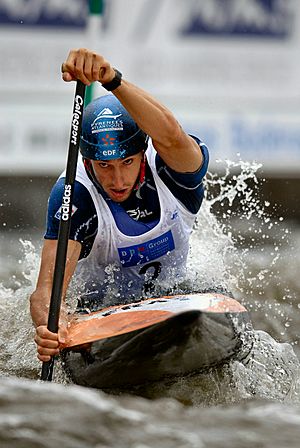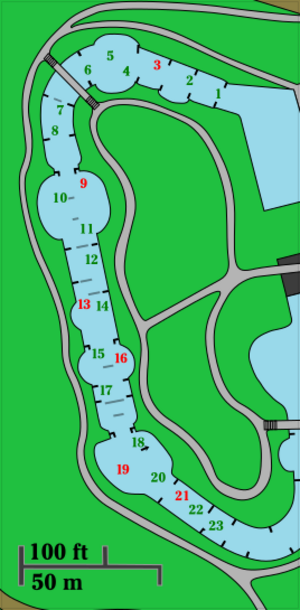Canoe slalom facts for kids
Canoe slalom is an exciting water sport. It involves guiding a special canoe or kayak through a course of hanging gates on river rapids. The goal is to get through all the gates as fast as you can!
This sport is one of two canoeing events at the Summer Olympics. The International Olympic Committee (IOC) calls it Canoe/Kayak Slalom. The other Olympic canoeing sport is canoe sprint.
Contents
History of Canoe Slalom
Canoe slalom racing first started in Switzerland in 1933. Back then, races were held on flat water.
In 1946, the International Canoe Federation (ICF) was formed. This group now manages the sport around the world. The first World Championships were held in Switzerland in 1949.
For many years, the championships happened every two years. Since 2002, they happen every year, except in Olympic years.
Early boats were made of heavy materials like fiberglass and nylon. They often weighed over 14 kilograms (30 pounds). In the 1970s, new materials like kevlar and carbon fiber were used. This made boats much lighter and faster.
The first World Championship held outside Europe was in Canada in 1979. Canoe slalom became a regular Olympic sport in 1992.
At the Tokyo 2020 Olympics, the men's C2 (canoe double) event was replaced by the women's C1 (canoe single) event.
How Canoe Slalom Works: Rules and Penalties
A canoe slalom course has 18 to 25 numbered gates. Each gate has two poles hanging from a wire across the river.
Some gates are green, meaning you go downstream through them. Others are red, meaning you must paddle upstream through them. Upstream gates are often placed in eddies, which are calmer spots in the water.
Most top paddlers finish a course in 80 to 120 seconds. Harder courses or slower paddlers might take up to 200 seconds.
Competition Format
In big competitions, all athletes do a first run in a "heats" round. The fastest boats move on to the semi-final. Others get a second chance to qualify.
At the Olympic Games, each athlete does two runs. Their faster time counts for qualification.
The fastest boats from the semi-final then go to the final. Their final ranking is based only on their time in that last run.
Understanding Penalties
To pass a gate correctly, the paddler's head (and all paddlers' heads in a double boat) and part of the boat must go through the gate.
- If a paddler's boat, paddle, or body touches a gate pole, a 2-second penalty is added to their time.
- If a paddler misses a gate, goes through it the wrong way, or in the wrong order, a 50-second penalty is given.
- Only the highest penalty counts for each gate. So, if you touch a gate and also go through it the wrong way, you only get the 50-second penalty.
Olympic Events
Currently, there are six Olympic medal events in canoe slalom:
- C1 (canoe single) Men
- C1 (canoe single) Women
- K1 (kayak single) Men
- K1 (kayak single) Women
- Kayak cross Men (added in 2024)
- Kayak cross Women (added in 2024)
Boats and Equipment
In the past, slalom boats were heavy. They were made of fiberglass and nylon. In the 1970s, new materials like Kevlar and carbon fiber made boats much lighter.
Today, racing boats usually cost between $1,200 and $2,500. They are made with carbon fiber, Kevlar, and fiberglass cloth. These materials are held together with special resins.
In 2005, the minimum length for boats was shortened from 4 meters to 3.5 meters. This led to new, faster boat designs. Shorter boats are also easier to steer and less likely to get damaged on man-made courses.
Boat Rules
The ICF has strict rules for boat sizes and weights:
- K1 (kayak single) boats must be at least 3.50 meters long and 0.60 meters wide. They must weigh at least 9 kilograms.
- C1 (canoe single) boats must be at least 3.50 meters long and 0.60 meters wide. They must weigh at least 9 kilograms.
- C2 (canoe double) boats must be at least 4.10 meters long and 0.75 meters wide. They must weigh at least 15 kilograms.
- Boats cannot have rudders.
- Kayaks are closed boats where paddlers sit and use a double-bladed paddle.
- Canoes are closed boats where paddlers kneel and use a single-bladed paddle.
Canoe Slalom Courses
Slalom courses are usually on Class II to IV whitewater. This means the water can be moderately difficult to very difficult.
Some courses have many rocks, making them very technical. Others have fewer rocks but bigger waves and holes.
Kayak Cross
Kayak cross, also known as extreme slalom, is a newer and very exciting discipline. Four kayaks race each other at the same time on one course. It's a bit like BMX racing or ski cross.
Competitors start by dropping into the water from a ramp. They must pass through gates and perform a kayak roll during the race. It's okay to have some contact with other boats, but dangerous paddling can lead to disqualification.
The first paddler to cross the finish line without any rule violations wins!
Canoe Slalom at the Olympics
Canoe slalom first appeared at the Olympics in 1972 in Augsburg, West Germany. After that, it wasn't seen again until 1992 in Spain. Since then, it has been a regular Olympic event.
Here are some of the places where Olympic canoe slalom has been held:
- 1972: Augsburg, West Germany
- 1992: La Seu d'Urgell, Spain
- 1996: Ocoee River, United States
- 2000: Penrith, Australia
- 2004: Athens, Greece
- 2008: Shunyi, Beijing, China
- 2012: Lee Valley, UK
- 2016: Rio de Janeiro, Brazil
- 2020: Tokyo, Japan
- 2024: Vaires-sur-Marne, Paris, France
Many Olympic courses are man-made concrete channels. The Augsburg Eiskanal course in 1972 was one of the first artificial whitewater courses. Since the 1980s, many countries have built artificial courses for training.
See also
 In Spanish: Piragüismo en eslalon para niños
In Spanish: Piragüismo en eslalon para niños
- Canoe Slalom World Cup
- ICF Canoe Slalom World Championships
- Canoeing at the Summer Olympics
- List of artificial whitewater courses




